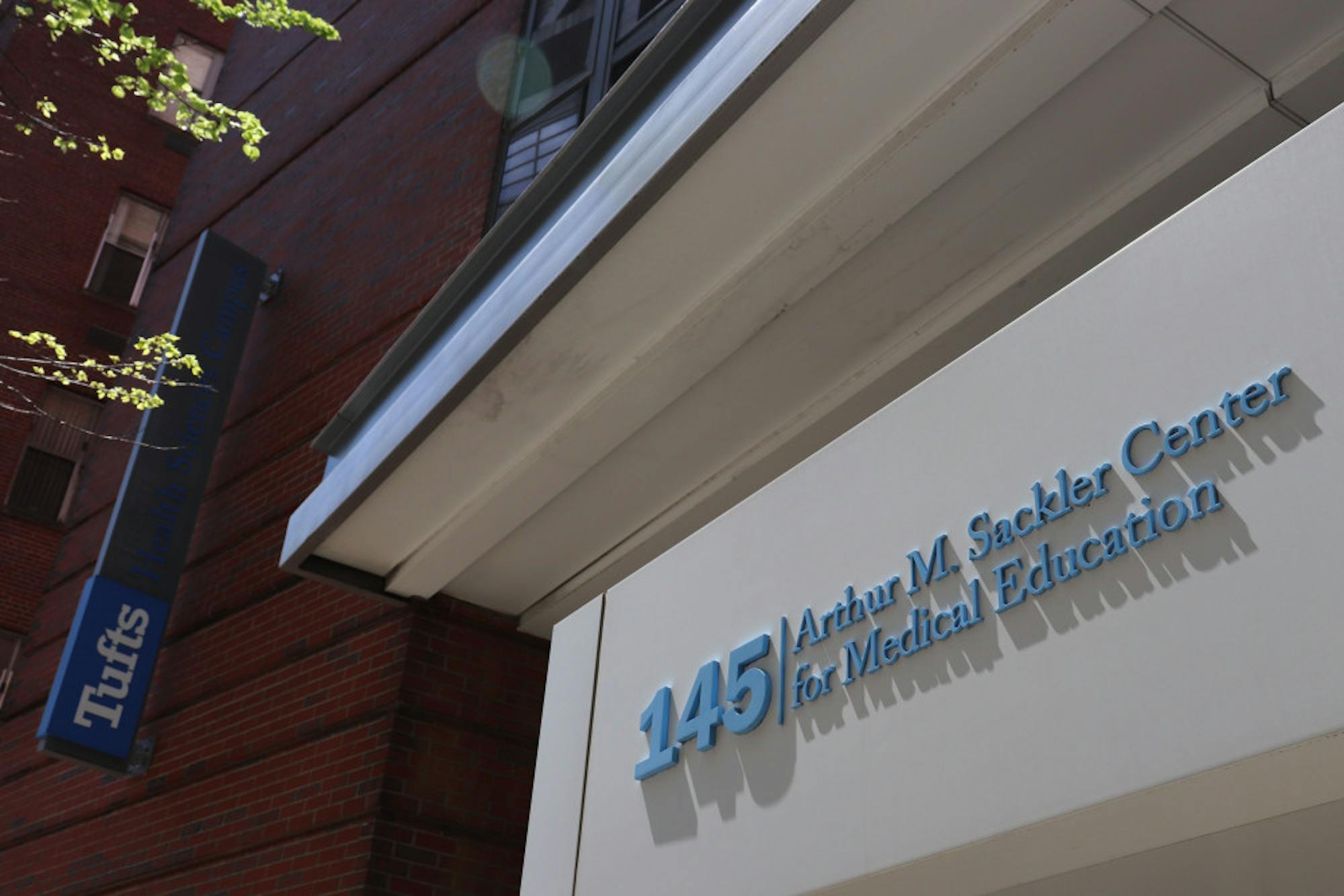A Blight on the Hill, the Tufts Daily’s investigative podcast, explores the ethical consequences of Tufts University’s pursuit of prosperity and prestige. The series’ second episode, ‘Oxycontin University,’ examines the decades-long relationship between the university and the Sackler family — and specifically its pharmaceutical conglomerate, Purdue Pharma — given recent scrutiny of the company’s role in driving opioid addiction.
https://open.spotify.com/episode/1s7JZIQO9gbpJc4ZcDrrMG
Tufts Medical School’s master’s degree in Pain, Research, Education and Policy (PREP) program was taught by doctors, nurses, dentists, health administrators and psychologists — experts in the multi-faceted world of treating pain.
In 2006, the PREP program began featuring another expert: anesthesiologist J. David Haddox, then an executive at Purdue Pharma, the embattled drugmaker that has sold and marketed the painkiller OxyContin, a powerful drug that can often lead to physical dependency.
Haddox’s recurring presence in the classroom — and his status as an adjunct associate professor — was one manifestation of Purdue’s close relationship with PREP, a program founded in 1999 after a six-figure gift from the Sackler family, owners of Purdue Pharma. Tufts is currently phasing the program out due to declining student interest, according to Tufts' Executive Director of Public Relations Patrick Collins.
In a lawsuit filed earlier this year against Purdue and the Sackler family, Massachusetts Attorney General Maura Healey alleges that the company’s support for the PREP program was part of a deceptive OxyContin marketing campaign that she says de-emphasized the drug’s addiction potential and bolstered prescriptions, helping to spark a statewide epidemic of opioid abuse.
Before his time at Tufts, Haddox spent the bulk of his career arguing that pain is undertreated, opioid painkillers are effective and abuse is exaggerated.
From his arrival at the university, Haddox began guest-lecturing on topics intimately connected with opioid use and the regulations surrounding their prescription, at times using Purdue-branded material.
The Daily’s investigation of the PREP program uncovered course notes, lecture slides and readings — accumulated during one student's track through the program nearly a decade ago. A number of these notes, alongside the Daily's other reporting for this story, shine a partial light on Haddox’s time at Tufts.
Tufts and the Sacklers
Tufts’ relationship with the Sackler family extends well before the PREP program or the rollout of OxyContin. The university created the Sackler School of Graduate Biomedical Sciences in 1980 after sizable donations from a trio of now-deceased Sackler siblings.
Though the PREP program did not bear the Sackler family name, its connections to the family were not a secret. On the program’s 10th anniversary in 2009, Professor of Public Health and PREP Program Director Daniel Carr lauded the Sacklers for their “indispensable” support.
Following the PREP program’s establishment, Purdue redoubled its connection to Tufts, regularly dispatching its staff to the school and meeting with program leaders to discuss potential collaborations, Healey’s filing claims.
“The Sacklers got a lot for their money,” the filing alleges. “The [PREP] Program bought Purdue name recognition, goodwill in the local and medical communities, and access to doctors at Massachusetts hospitals.”
Sometimes this collaboration took the form of damage control. Donning a white lab coat, Carr lauded Purdue in a 2002 Boston Globe advertisement, noting the company’s efforts to control a then-nascent spike in prescription drug abuse. The ad included the company’s logo, acknowledged the abuse issue and declared that “Purdue Pharma is doing something about it.”
Carr referred a request for comment to Collins.
The Sacklers also served as the namesake for a Tufts lecture series that featured pain management experts.
Purdue’s targeting of Tufts is not unique. Other universities were also awash with Sackler gifts, but the company’s work at Tufts was extensive enough to earn its sales team praise for — according to Healey’s filing — “penetrating this account.”
According to Collins, though the PREP program initially had some financial support from Purdue, Tufts has funded the program through other sources in recent years. Purdue spokesperson Robert Josephson said the company’s financial support for the program ended in 2008.
Josephson said Healey’s lawsuit “grossly distorts and mischaracterizes” the company’s relationship with Tufts, citing a motion to dismiss filed by the company.
“Purdue has a long history of supporting pain research at Tufts University. Such collaborations between industry participants and research universities are common and widely viewed as appropriate,” Josephson told the Daily in a statement. “Purdue acted properly at all times in its interactions with Tufts.”
Tufts has begun an independent review of PREP and other Sackler- and Purdue-connected programs at the university led by former U.S. Attorney for Massachusetts Donald Stern, the school announced in March. Collins declined to comment on the nature of Purdue’s ties to the PREP program, citing Stern’s ongoing review.
One facet of this relationship, Healey’s filing notes, was the 2011 appointment of an unnamed Purdue employee to the rank of adjunct associate professor at Tufts. Former Purdue Vice President of Health Policy J. David Haddox held the same title. Collins confirmed that Haddox became an adjunct professor in July 2006, and was later promoted to adjunct associate professor, though his teaching role was limited to a few lectures per year. He no longer teaches at the school.
Haddox’s History
Bearing an M.D. and a doctorate of dental surgery (DDS), Haddox worked as a clinician through the 1980s and 1990s before moving to Purdue in 1999. Haddox served as Purdue’s defender in the press, arguing that OxyContin abuse was less dire than media reports claimed. Haddox’s public statements occasionally ran counter to Purdue’s private knowledge of the problems mounting for its marquee drug.
Haddox spent the years before and after OxyContin’s 1996 rollout doubling down on his support for opioid painkillers. He helped prepare a 1996 statement from the American Pain Society and the American Academy of Pain Management — for which he later served as president — asserting that opioids are often useful for chronic pain and the risk of abuse in patients without a history of addiction was low.
Haddox knew Purdue had a problem by 1999, when the arrest of several doctors for illegal prescriptions led Haddox to send an email recommending a company crisis-response plan, according to a confidential Justice Department report cited by The New York Times. In the same year, Purdue’s sales staff heard reports of abuse from doctors, and the sales staff toned down unsubstantiated claims about OxyContin’s low abuse potential two years later, according to a 2015 deposition of ex-Purdue President Richard Sackler that was unsealed in February.
The company’s research into abuse was limited following the drug’s release, however. Purdue’s counsel confirmed in 2015 that the company never retained anyone to study addiction in the drug’s early years, according to the deposition.
Despite Purdue’s lack of studies as well as the anecdotes about abuse, Haddox disputed a 2001 New York Times article that documented opioid addiction, OxyContin overdose risk and Purdue sales reps’ aggressive practices. Haddox responded to the charges in a 2001 Times letter to the editor that did not cite any formal research, relying instead on “discussions with medical examiners in several states” to argue that abuse is oversimplified.
“The media frenzy about OxyContin abuse is interfering with good pain management,” Haddox, Purdue’s senior medical director for health policy at the time, wrote in his letter. “In fighting drug abuse, we must not limit patients’ access to strong analgesics to manage pain and preserve quality of life.”
Throughout 2001, Haddox repeated this claim that opioid abuse is less dire than pain under-treatment. Even more starkly, Haddox insisted at a 2003 conference that OxyContin is not addictive as prescribed, according to The New Yorker. He had instead attributed OxyContin’s widespread misuse to — according to The New York Times — ‘bad guys’ who are illegally trafficking the drug, affirming that it has a generally low rate of abuse when prescribed lawfully.
“A lot of these people say, ‘Well, I was taking my medicine like my doctor told me to,’ and then they start taking more and more and more,” Haddox told the Associated Press in 2001. “I don’t see where that’s my problem.”
In an interview with the Daily, Jane Ballantyne, a University of Washington Medical Center anesthesiologist who regularly gave lectures as part of Tufts’ PREP program, said Purdue vastly understated OxyContin’s addiction risk. She believes the company spread misleading claims about the drug’s addiction potential by suggesting that its “long-acting” preparation would make addiction less likely than other painkillers when, in reality, this difference was small and unproven, according to Ballantyne. Ballantyne disclosed in September 2019 that she received payment from Motley Rice LLC, the co-lead counsel in pending litigation against a group of opioid manufacturers that includes Purdue Pharma, as a consultant for the law firm.
Despite these concerns, Purdue’s efforts to convince the public that pain is undertreated were influential in leading to the drug’s overprescription, according to Ballantyne. The culture surrounding pain treatment changed in the 1990s, she explained, and many doctors’ caution surrounding opioids for chronic pain was replaced by interest in an effective painkiller.
"Part of their promotional activity was very much to convince people not only that pain was undertreated and there was a crisis of undertreatment of pain, but also that you had a moral or an ethical obligation to treat pain as a doctor," Ballantyne said. "If you didn't, you were either a bad person or a bad doctor."
Haddox’s job as a Purdue executive was anchored in decades of research into pain management, driven by a belief that opioid painkillers are effective and pain is undertreated. In a landmark 1989 paper, he claimed that many people whom doctors accused of drug addiction are not addicts at all, but rather patients with an unmet need for pain treatment. This “pseudoaddiction,” which drives pain-stricken patients to show addict-like behaviors like asking for prescriptions incessantly, can be resolved through better pain management, Haddox wrote.
Researchers funded by large pharmaceutical companies — including Purdue — began invoking Haddox’s “pseudoaddiction” term to support the notion that painkillers are under-prescribed. The idea is far from settled science, though: Some researchers have questioned the concept and, according to a 2014 review, no published study has proven the pseudoaddiction theory empirically, with most of its defenders reliant on anecdotes.
Edgar Ross, the director of Brigham and Women’s Hospital’s Pain Management Center and another PREP lecturer, believes pseudoaddiction applies to, at most, an extremely small number of patients. Ballantyne, meanwhile, said pseudoaddiction is a problematic theory because it masks actual addiction, encouraging doctors to miss warning signs and dangerously over-prescribe medication.
“There's no such thing as pseudoaddiction. It's just a concept,” Ballantyne said. “And it's a bad concept because it encourages people to give more opioids.”
Beyond the risk of addiction, Ballantyne believes OxyContin’s benefits were wholly overstated. She says most chronic pain patients are better served without OxyContin.
“The risk isn't worth taking, in my view, for most people,” Ballantyne said. “Most common pain conditions do better if you avoid opioids altogether.”
By the time Haddox reached Tufts in the late 2000s, nationwide prescription opioid overdose deaths had more than doubled from 1999. As overdose deaths continued to increase, he acknowledged the problem.
Haddox addressed the abuse issue by the 2010s, when concerns surrounding opioids became well-known. He wrote papers on abuse-deterrent opioids, an area of business that Purdue has declared itself a leader in, and he was listed as an inventor on atleastthree patents for tamper-resistant opioids.
Haddox, who retired from Purdue last year, did not respond to multiple requests for comment. In response to Healey’s lawsuit, Josephson, Purdue’s spokesperson, cited the company’s motion to dismiss. Purdue argues that OxyContin cannot be blamed as the sole cause of an opioid abuse epidemic that is now primarily driven by heroin and other illicit drugs, and that the company’s marketing followed federal guidelines.
Josephson also cited a North Dakota lawsuit similar to Healey’s that was dismissed earlier this month. A North Dakota judge found that Purdue does not control how OxyContin is prescribed or used, so the company is not held liable for allegedly bolstering sales through marketing.
Ross, the PREP lecturer, says it is unclear whether Purdue deliberately spread misinformation, but he believes OxyContin was overprescribed and its addiction risk was underrecognized. He says Haddox, among other physicians, promoted a view of opioid painkillers that was, in retrospect, over-simplified. While opioids can be part of a treatment strategy, Ross noted, they should not be the sole means of addressing pain.
“Treatment of pain is much more complex than [Haddox] was saying,” Ross said. “His statements imply that opiates should be front and center in the treatment of chronic pain.”
Haddox at Tufts
Haddox lectured for at least two separate courses in the PREP program, and on both occasions, was forthright about his connections to Purdue Pharma, a Daily review of course notes shows. Josephson says Tufts invited Haddox to speak, and he was unpaid for his work.
The first 2007 class was “PREP234: Introduction to Clinical Pain Problems,” according to the course’s archived OpenCourseWare webpage.
Haddox’s lecture week in 2007 was dedicated to opioid-related topics. He presented two slide decks, according to the course page: one on the use of urine drug testing in clinics, and one on the opioid class of analgesics — a medical term for painkillers. In both instances the slides list Haddox’s employer, Purdue Pharma, as the copyright holder for the “Restricted Use” materials.
“This lecture guide and accompanying slides are provided as a professional service by Purdue Pharma L.P,” slide four of the “Opioid Class of Analgesics” presentation reads.
The slides feature extensive disclaimers from Purdue Pharma. “Purdue provides the content of this Program for informational purposes and for your general interest only,” the slides’ “LIMITATION OF LIABILITY” sections read in part. “By using this Program you hereby agree not to rely on any of the information contained herein.”
Haddox also lectured in the Introduction to Clinical Pain Problems class on April 16, 2009, handwritten course notes and lecture slides acquired by the Daily from alumna Holly Roche (PREP ‘11) show. There, the notes and slides indicate an evolution in his teaching style as well as in his presentation of information: He no longer featured Purdue-branded curricula.
His lecture was titled “Assessment and management of chronic pain with an emphasis on the appropriate use of opioid analgesics.” The stated objective of the class, as outlined by Haddox’s lecture slides, was to help students describe how opioid analgesics function and when to order urine drug tests.
The April 16, 2009, class also featured a discussion about the potential pitfalls of upcoming drug regulation, the handwritten class notes show. Toward the end of the lecture, a student asked Haddox about the FDA’s Risk Evaluation and Mitigation Strategy (REMS), a risk/benefit regulatory program that mandates producers of certain medications, like modified release oral opioids, to develop risk management safety plans for their use.
One aspect of REMS the ensuing discussion focused on was “Elements to Assure Safe Use,” a more complex regulatory mandate within REMS that would set restrictive certification and registration requirements across drug prescribers, dispensers and patients, according to the notes. The discussion mentioned REMS’ potential limitations, especially the risk that patients will be mistakenly denied medication.
References to pseudoaddiction — Haddox’s controversial theory — appeared in at least two different lectures during the PREP program: a lecture on opioids during the fall 2007 “Palliative Care and End of Life Issues” class, and readings provided to students as a part of Haddox’s lecture in the “Public Policy, Legislative, and Forensic Issues in Pain” class on Oct. 27, 2010.
Alongside academic and policy papers, the readings for Haddox’s 2010 Policy lecture included two newspaper op-eds warning that stronger restrictions on opioid prescriptions could hurt pain patients. Reading materials also include the 1996 statement co-written by Haddox that claimed opioids are often useful for chronic pain. A more tempered 2004 statement from the same organization, the American Academy of Pain Medicine, appeared during another week’s lecture readings.
According to Roche, a massage therapist who attended the PREP program between 2007 and 2011, Haddox told students during one lecture that OxyContin’s controlled-release preparation should mitigate the risk of addiction, a claim Ballantyne said is disputed. Roche said she recalled Haddox as a compelling speaker — one of the few she remembered from the class.
Other course notes indicate that students were taught about addiction and other potential risks of OxyContin use. One legal case study by PREP lecturer Srdjan Nedeljkovic, an anesthesiologist at Brigham and Women’s Hospital, described a chronic pain patient who should no longer take OxyContin. Efforts to reach Nedeljkovic for comment were unsuccessful.
Evaluating Purdue Pharma and Tufts
Most former students who spoke with the Daily did not feel that the program had an angle or agenda to push.
“Nobody was ever trying to lobby me, change my opinions on how these things worked,” Roche said. “Everybody said that the more strategies you try, the better everything works synergistically.”
Likewise, 2004 graduate Hallie Greenberg and 2010 PREP certificate recipient Charlene Neu say the program offered a comprehensive and balanced overview of pain management. Neither student took a class featuring Haddox, though Greenberg met with him during a PREP-related event. Greenberg believes OxyContin was overprescribed and Purdue’s marketing was misleading, but that the company’s support for the PREP program was not problematic.
“It’s very fashionable to vilify Purdue Pharma. They did some bad things. They did not educate people correctly,” Greenberg said. “But I think that to start reviling schools that take money from big pharma is not the way to go.”
Josephson, Purdue’s spokesperson, says the company did not control the PREP program’s curriculum and Haddox’s relationship to Purdue was always disclosed. He added that Haddox, who retired from Purdue last year, did not present about or promote Purdue’s products and that he gave factual answers if students asked about Purdue’s drugs.
For their part, three experts who lectured in PREP courses regularly — Ballantyne, Ross and workers’ compensation lawyer Paul Goodrich — told the Daily that they prepared their own lecture materials and that they were unpaid for their work with PREP.
Ballantyne and Ross believe Haddox’s affiliation with Tufts is not inherently problematic as long as his Purdue ties were disclosed. According to Ballantyne, it is not unusual for pharmaceutical employees to have academic appointments.
Industry funding is common in academia and frequently useful, Ballantyne and Ross said, and disclosure is a good defense against potential issues.
“There’s an inherent conflict with the collaborative effort between industry and academia,” Ross said. “There’s also an enormous synergy.”
Ballantyne has seen this potential for conflict firsthand. When she ran Massachusetts General Hospital’s Pain Center in 2000, Purdue sponsored the hospital’s pain program, earning the program’s naming rights. Purdue offered funding for educational resources, produced glossy teaching materials and sponsored seminars, she said. She now believes the company was attempting to target her and other leaders in the pain field in an effort to market its prescription painkillers.
For Ballantyne, Purdue’s collaboration with institutions like Tufts and Massachusetts General Hospital served as one tool to bolster perceptions of OxyContin, leading to a change in the way pain is treated in the United States.
“We like to think we're open-minded and not influenced by it,” Ballantyne said, “but then, retrospectively, yes, we are influenced by it.”
UPDATE (11/25/19): Dr. Jane Ballantyne, a University of Washington Medical Center anesthesiologist who regularly gave lectures as part of Tufts’ PREP program, disclosed in September 2019 that she served as a paid consultant for Motley Rice LLC, the co-lead counsel in pending litigation against a group of opioid manufacturers that includes Purdue Pharma. The article has been updated to include this information.
Inside the Purdue Pharma-Tufts relationship

The former Arthur M. Sackler Center for Medical Education is pictured on June 19.





